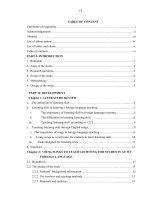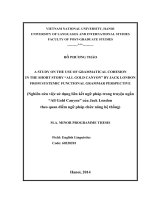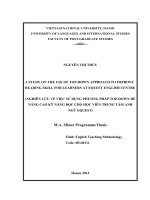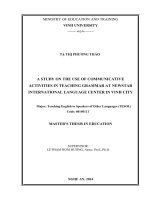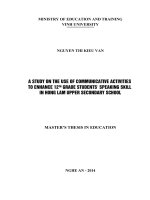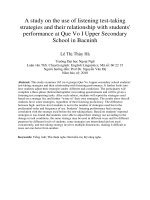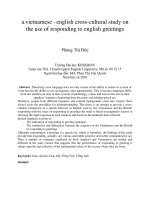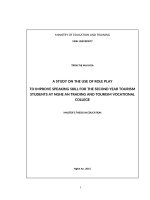A STUDY ON THE USE OF STORYTELLING TO IMPROVE SPEAKING SKILLS FOR SEVENTH GRADERS IN AN ENGLISH CENTER
Bạn đang xem bản rút gọn của tài liệu. Xem và tải ngay bản đầy đủ của tài liệu tại đây (501.53 KB, 96 trang )
MINISTRY OF EDUCATION AND TRAINING
VINH UNIVERSITY
BUI THI NHAM
A STUDY ON THE USE OF STORYTELLING
TO IMPROVE SPEAKING SKILLS FOR SEVENTH
GRADERS IN AN ENGLISH CENTER
MASTER THESIS IN EDUCATION
VINH, 2017
BÙI THỊ NHÂM
A STUDY ON THE USE OF STORYTELLING
TO IMPROVE SPEAKING SKILLS FOR SEVENTH
GRADERS IN AN ENGLISH CENTER
Teaching English to Speakers of Other Languages (TESOL)
Code: 60.14.01.11
MASTER THESIS IN EDUCATION
SUPERVISOR: NGUYỄN THỊ KIM ANH, Ph.D
ACKNOWLEDGEMENT
I would like to express my sincere gratitude to my thesis supervisor Ph.D.
Nguyen Thi Kim Anh, vice dean of Foreign Language Department at Vinh
University, for her invaluable guidance, constructive suggestions, cooperation and
constant encouragement during the period of the study.
I would also like to extend my sincere gratitude to all the teachers of the
Foreign Language Department at Vinh University, some teachers from Vietnam
National University as well as the staff of the Department of Postgraduate studies,
whose lectures and ideas have inspired my thesis and who it is impossible to thank
individually
I highly appreciate the supports I receive from the teachers as well as students
in my workplace for their cooperation in giving me information.
Last but not least, I duly acknowledge the authors whose ideas are borrowed
and cited in this study.
Due to limited scope, it is sure that in this paper, mistakes are inevitable. I
hope to receive further comments and advice to make it better.
1
ABSTRACT
This research work entitled “A Study on the Use of Storytelling to Improve
Speaking Skill for Seventh Graders in an English center” aims to explore the
effect of storytelling on students’ speaking skill.
This research was conducted at the seventh grade of an English center in Vinh
city. The study involved 48 students in two classes of seventh grade in “the New Star
English Center”. The instruments used were speaking tests (pretest and posttest)
pilot teaching and questionnaires.
Based on the findings, it is recommended that the teachers need to use
storytelling technique to teach speaking skill. This study believes that storytelling is
very important in teaching English speaking skill because it motivates students and
creates chances for students to speak. It also allows students to be creative and
actively participate in speaking lessons. More importantly, it is proven that the use of
storytelling improved the students’ pronunciation, grammar, vocabulary and fluency.
ACKNOWLEDGEMENT.......................................................................................................i
ABSTRACT..............................................................................................................................ii
2
LIST OF TABLE...................................................................................................................vii
LIST OF FIGURE................................................................................................................viii
Chapter 1...................................................................................................................................1
INTRODUCTION...................................................................................................................1
1.1. Rationale..........................................................................................................................1
1.2. Aims of the study............................................................................................................2
1.3. Research question...........................................................................................................3
1.4. Scope of the study...........................................................................................................3
1.5. Method of the study.......................................................................................................3
1.6. Organization of the study..............................................................................................4
Chapter 2...................................................................................................................................5
LITERATURE REVIEW AND THEORETICAL BACKGROUND..............................5
2.1. Review of Previous Studies...........................................................................................5
2.2. Speaking skills.................................................................................................................6
2.2.1. Definition of speaking skills.......................................................................................6
2.2.2. Elements of speaking..................................................................................................7
2.2.3. Historical overview of the teaching of speaking skills...........................................8
2.2.4. The importance of speaking skills in language learning.....................................10
3
2.2.5. The characteristics of speaking skills.....................................................................11
2.2.6. Principles of teaching speaking skills.....................................................................12
2.2.7. Problems in teaching speaking skills......................................................................15
2.2.8. Stages of teaching speaking skills...........................................................................16
2.2.9. Characteristics of a successful speaking activity..................................................17
2.2.10. Activities to develop speaking skills.....................................................................18
4
2.2.11. Ways of organizing speaking activities................................................................19
2.3.1. Definitions of storytelling.........................................................................................21
2.3.2. Types of stories...........................................................................................................22
2.3.3. A variety of telling activities....................................................................................23
2.3.3.1. Five- finger telling stories - Prompts for stories................................................23
2.3.3.2. Oral telling story using prompts..........................................................................24
2.3.3.3. Chalk talk................................................................................................................24
2.3.3.4. Dramatizations.......................................................................................................24
2.3.4.
The advantages of storytelling..............................................................................24
2.3.4.1. The advantage of storytelling in learning speaking skill..................................24
2.3.4.2. The advantages of storytelling in teaching speaking skill................................25
2.3.4. Ways in building up storytelling ability.................................................................26
2.3.4.1. Single-word story...................................................................................................26
2.3.4.2. Sentence story.........................................................................................................26
2.3.4.3. Writing story in big circle.....................................................................................26
2.3.5. Applying storytelling in teaching and learning.....................................................27
Chapter 3.................................................................................................................................30
METHODOLOGY................................................................................................................30
3.1. Participants...................................................................................................................30
3.2. Materials........................................................................................................................30
3.3. Procedures.....................................................................................................................31
3.4. Tools for Data collection..............................................................................................32
3.4.1. The questionnaires....................................................................................................32
3.4.2. Experimental plan.....................................................................................................33
3.5. Data analysis.................................................................................................................33
3.6. Research procedures....................................................................................................33
Chapter 4.................................................................................................................................34
FINDINGS AND DISCUSSION..........................................................................................34
4.1. Teachers’ responses......................................................................................................34
4.1.1. Teachers’ profiles................................................
4.1.2. Teachers’ perception towards speaking skill and teaching speaking skill........34
4.1.3. Teachers’ difficulties in teaching speaking skill....................................................36
4.1.4. Teachers’ opinions about the use of storytelling in teaching English................37
4.2. Students’ responses.......................................................................................................38
4.2.1. Students’ profile.........................................................................................................38
4.2.2. Students’ perception towards four skills andspeaking skill................................39
4.2.3. Students’ difficulties in speaking lessons...............................................................43
4.2.4. Students’ perception towards storytelling technique...........................................44
4.2.5. Students’ participation in speaking lesson.............................................................47
4.2.6. Benefits of storytelling to students’ speakingskill.................................................48
4.2.7. Difficulties encountered in telling stories...............................................................48
4.2.8. Pretest and posttest score.........................................................................................49
4.3. Discussion......................................................................................................................52
4.3.1. The effectiveness of storytelling technique............................................................52
4.3.2. Difficulties...................................................................................................................55
4.4. Summary........................................................................................................................56
Chapter 5.................................................................................................................................57
CONCLUSIONS AND IMPLICATIONS..........................................................................57
5.1. Conclusions....................................................................................................................57
5.2. Implications...................................................................................................................58
5.3. Suggestions on using storytelling to develop speaking skills for students in
speaking class......................................................................................................................58
5.3.1. How to choose a good story?....................................................................................58
5.3.2. How to organize storytelling?..................................................................................58
5.4. Limitations.....................................................................................................................59
5.5. Suggested further research.........................................................................................59
REFERENCES......................................................................................................................60
APPENDICES........................................................................................................................64
STT
: Storytelling technique
Q1
: Questionnaire number one
Q2
: Questionnaire number two
SA
: Strongly agree
A
: Agree
N
: Neutral
D
: Disagree
SD
: Strongly disagree
Ss
: Students
T
: Teacher
%
: Percent
Table 4.1. Teachers’ profile.....................................................................................34
Table 4.2. The teachers’ difficulties in teaching speaking skills..............................36
Table 4.3. Teachers’ suggestion on encouraging students to speak.........................37
Table 4.4. Students’ profile.....................................................................................38
Table 4.5. Students’ difficulties in speaking class...................................................43
Table 4.6. Students’ feeling of personal enjoyment.................................................46
Table 4.7. Benefits of storytelling in speaking class...............................................48
Table 4.8. Students’ difficulties in telling story.......................................................49
Table 4.9. Distribution of pretest score...................................................................50
Table 4.10. Distribution of posttest score................................................................51
Table 4.11. The increase of students’ score in four aspects of speaking..................51
Figure 4.1. Teachers’ opinion about the speaking skills..........................................35
Figure 4.2. Teachers’ perception about teaching speaking skills.............................35
Figure 4.3. Teachers’ perception about the use of storytelling in speaking class.....38
Figure 4.4. Students’ awareness about language skills............................................39
Figure 4.5. Students’ attitude towards speaking skills.............................................40
Figure 4.6. Students’ attitudes towards speaking lesson..........................................41
Figure 4.6.1: How interesting?................................................................................41
Figure 4.6.2: How difficult?....................................................................................42
Figure 4.7. Students’ opinion about participating in speaking
class....................43
Figure 4.8. Students’ attitudes towards the use of storytellingin classroom............44
Figure 4.9. Students’ perspectives towards stories..................................................45
Figure 4.10. Students’ attitudes towards telling stories...........................................45
Figure 4.11. Students’ participation in speaking lesson...........................................47
Chapter 1
INTRODUCTION
1.1. Rationale
In the flow of globalization, English has been widely used in Vietnam in
different fields such as economics, politics, culture, science, technology, education
and tourism. English has maintained its dominant role as the first foreign language in
Vietnam for a long time. Hundreds of English language centers have been
established all over the country.
It is important to use English in conversation, especially in learning speaking.
The mastery of speaking skill is priority for many second and foreign language
learning as their success in learning is evaluated on the basic of how fluent they are
in English conversation. Therefore, in order to speak English well, learners must pay
great attention to learning well (Richards, 1990).
The notion of English as an international language has prompted the
importance of speaking skill. The Ministry of Education and Training has introduced
the new pilot English textbook which not only focuses on 4 skills equally but also
provides student knowledge about English speaking cultures. It would be better if
learners can speak it for communication in different contexts and situations.
However, how to teach and learn English in Vietnam has still been encountering
many problems. Many students from elementary school to senior high school and
even university have trouble in speaking English or have limited ability to use
English as a communicative tool in real life, even though the National curriculum
has put English as a compulsory subject and obliges students to learn English.
There are internal and external factors which cause this problem. The former
1
factors come from students themselves. They are afraid of making mistakes, are shy
to speak or do not want to speak. The later ones are mostly related to the teachers
themselves and their abilities in handling the teaching- learning process, such as
teaching technique, motivation, mastering of materials and class management.
These days, it is fundamental to communicate in second language in which
speaking skill is an important element in the process of communication. Brown and
Yule (1983) believe that many language learners regard speaking skills as the criteria
for knowing a language. In other word, it is a priority for learners in evaluating their
success in learning, on the basic of how fluent they feel that they become in their
spoken English foreign language.
To improve the speaking ability of the students, there are several different
techniques that can be used such as role playing, giving speeches, group discussions,
storytelling etc. Storytelling is one of the techniques commonly used and one of
interesting technique which can be employed in language learning. However, it is
not fully exploited by secondary school teachers in my center.
This is reason why I choose to conduct the research titled “A study on the use
of storytelling to improve speaking skills for seventh graders in an English
center”. I hope my study will make some contributions to the improvement of
speaking ability.
1.2. Aims of the study
The aims of this research are to find out whether the implementation of
storytelling technique would help improve students speaking ability and how
effective of this technique is on four aspects of speaking skills, namely
pronunciation, grammar, vocabulary and fluency.
2
1.3. Research question
There are two research questions to be addressed in this study:
1. What are students’ attitudes towards the use of the storytelling technique in
their speaking class?
2. What are the benefits of storytelling for 7th graders in the classroom?
3. Can storytelling improve student’s fluency, grammar, vocabulary,
pronunciation and comprehension?
1.4. Scope of the study
Due to the limitation of time and knowledge, the study focuses specifically on
using storytelling in teaching speaking skills for secondary school students. So the
study restricts itself to the teaching and learning speaking only and the subjects of
the study are students from an English center in Vinh city.
1.5. Method of the study
This study employed both quantitative and qualitative methods including
survey questionnaires, experimental plan and class observation.
Firstly, for its versatility and straightforward data processing, the survey
questionnaires were employed to collect data quickly from a large number of
participants.
Secondly, an experimental plan was conducted, in which there was an
experimental group which was taught speaking skill with storytelling technique and
a conventional group. In the study there was a pretest and a posttest to evaluate the
implementation of storytelling.
Lastly, class observation was used to investigate the issue in practice with an
objective view.
3
1.6. Organization of the study
The study consists of 5 chapters.
Chapter 1 provides an introduction to the topic of the study by stating
rationale, aim, scope, research questions, method and organization.
Chapter 2 reviews the theoretical background concerning teaching and learning
speaking skills and storytelling.
Chapter 3 includes the setting of the study, participants and techniques for
collecting data.
Chapter 4 deals with the findings and discussions from statistical results.
Chapter 5 draws conclusion by explicitly answering the research questions,
give some recommendations for English language practitioners and proposes topics
for further research.
The study ends up with ‘References’ providing a list of sources of materials
which are used during the process of writing the study and ‘Appendix’ with the
survey questionnaires for students.
4
Chapter 2
LITERATURE REVIEW AND THEORETICAL BACKGROUND
This chapter shapes the background that is relevant to teaching and learning
speaking skill as well as storytelling.
2.1. Review of Previous Studies
Related to the implementation of Storytelling Technique (STT) in teaching,
several previous studies have been conducted. First, a research was done by Fikriah
(2016). This study was designed as Classroom Action Research project to study the
effectiveness of using storytelling to improve English speaking skill of primary
school students. The purpose of this study was to give meaningful results either for
theoretical or for practical concerns for improving teaching for ESL speaking or for
other skills. This research was conducted in two cycles with each circle consists of
three meetings. The instruments used for collecting the data were observation sheets
for the teacher and students, and a speaking test and questionnaire for students. After
analysis, it could be concluded that the implementation of STT for teaching with
narrative texts was effective not only to improve students speaking ability but also
the ability to produce fluent and comprehensible grammatical correct sentences.
Another study was done by Herminda (2013); this experimental design aimed
to study the effect of storytelling on improving speaking skills of second year
students at SMPN 1 Boyolangu, Tulunggagung. The purpose of the study was to find
out if there were any significant differences in students speaking ability before and
after using storytelling technique. The data analysis used a t-test. The results of the
test showed that students speaking ability was improved after using this technique.
Another study, by Kusumastusi (2010), was an exploratory study to study the
effect of storytelling on growth reading interest among kindergarten students in
Pabelan, Semarang. The purpose of this study was to determine the extent of the
effect of storytelling on growth in reading interest of children in a kindergarten. 52
kindergarten children involves in this. The data collection technique used
questionnaires and interviews. The results that students really enjoyed the
storytelling activities with 91% of participants showed that the use of storytelling
gave a great boost to the growth in reading interest.
2.2. Speaking skills
2.2.1. Definition of speaking skills
Speaking skills refers to communication in the light of linguistics. It is
supposed to be one of the most important practical skills. Speaking is the productive
skill in the oral mode. Speaking skills of a second or foreign language is regarded as
a very complicated task. So far there are different ways to define speaking. Each way
focuses on one aspect of speaking. However, they all state speaking involves in
speech and through speak speaker expresses his ideals, feelings, etc. Brown and Yule
(1983) define “speaking as an interactive process of constructing meaning that
involves producing, receiving and processing information”.
Sharing the same idea, Chaney (1998) considered speaking as “the process of
building and sharing meaning through the use of verbal or non-verbal symbol in a
variety of contexts”.
A comprehensive discussion of the nature of speaking is provided by Bygate
(1987), who shows that in order to speak a foreign language, it is obviously
necessary to have micro-linguistic skills, that is, to understand some grammar,
vocabulary and the rules governing how words are put together to form sentences.
However, these motor perceptive skills, as Bygate call them, are not sufficient since
while producing sentences, we often have to adapt them to the circumstances. He
then presents the second set of speaking skills: the interaction skills, which involve
using knowledge and basic motor-perception skills in deciding what to say and how
to say it, while maintaining the intended relation with others.
Kramsch (1993) claims that “speaking means negotiating and adjusting one’s
speech to produce the desired effect on the listener”. To hold the interaction in
speaking, both speaker and listener have to work together and they must pay
attention to what is being said to avoid misunderstanding and misinterpretation
during the speaking. In this case, the speaking interaction between a speaker and
listener is an event that provides information which they must pay attention to tackle
well to ensure understanding of the oral communication.
Different linguistics define concepts of speaking in different ways but they all
agree that if learners do not learn how to speak or do not get any opportunities to
speak in the language classroom, they may soon get demotivated and lose interest in
learning. On the contrary, if the right activities are taught in the right way, speaking
in class can be a lot of fun, raising general learner participation as well as motivation,
making the English language classroom a fun and dynamic place to be.
2.2.2. Elements of speaking
Harmer (2001) claimed that some elements should be included in spoken
language: the first one is being connected speech, the second one is an expressive
device, the third one Lexis and grammar and the last one negotiation language.
Being connected speech refers to the ability to sound words correctly and connect the
sound to words to each other. Expressive devices include pitch change, intonation,
and stress to convey different meaning. The third reflects the ability of using phrases
in appropriate way depends on the language function. The last elements means that
the speaker can make clarification and display good talking structures by creating
effective speaking.
Brown (2001) also indicated that rhythm and intonation, fluency and accuracy
are three aspects of speaking. Speaking fluency means being able to communicate
one’s ideas without having to stop and think too much about what one is saying.
Accuracy reflects the speaker’s ability in using the word naturally.
2.2.3. Historical overview of the teaching of speaking skills Throughout
history of foreign language teaching, speaking skills have not always been central in
second language teaching methodologies although the practice of speaking in
classroom is a key element in the development of second language.
The Grammar Translation Method grew up in the early eighteenth century to the
nineteenth century. This method traditionally focused on reading texts and sentences,
translating them from the L1 to the L2 and vice versa. Richard and Rodgers (2001)
state that “Grammar Translation is a way of studying a language that approaches the
language, first through detailed analysis of its grammar rules, followed by
application of this knowledge to the tasks of translating and sentences and texts into
and out of the target language”. Hence, the progress in language was measured by
the ability to read prestigious literacy texts as well as the translation of passages from
one language to another.
Moving on, the Reform Movement (Howatt, 1984) considered that resorting to
comparison with the L1 was not the best way to achieve fluency in L2 use. Instead,
speech was seen as a key element in the teaching of language. Speech as a medium
for learning therefore came to be used in a variety of different approaches which
embraced the scope it offered for immediacy, correction and repetition.
In the end of the nineteenth century, the Direct method appear to compensate the lack
committed by the Grammar Translation method, it supported the idea that any
foreign language could be taught without translation or the use of the learner’s
mother tongue if the meaning is conveyed. Richard and Rodgers (2001) claimed that
the native speaker’s language is the model, but it supports creating an oral based
methodology. Its emphasis was placed very firmly on the spoken language which can
be successfully realized through a systematic attention to pronunciation. The Direct
method takes oral communication as fundamental and pronunciation is emphasized
from the outset; as opposed to the grammar translation method, the student’s native
language is not used in the classroom.
The Audio-Lingual method has appeared by the entry of USA into the World War II.
This method was based on a bending of principles, of behavior psychology and
percepts of structural Linguistics. It emphasizes language structures with vocabulary
and grammar structures tending to be presented through dialogue which are learned
by imitation and repetition.
In the early 1970s the Silent Way method appeared. The basic tenets of the approach
are that learning is facilitated if the learner discovers rather than remembers or
repeats. In other word, it supports the idea that student must take part in their
learning by taking their responsibilities to choose their own strategies rather than
repeating inputs from teacher. In the Silent Way, the personal aspect of speech can be
seen in the focus on the use of language for self-expression and on developing
independence from teacher.
The Total Physical response was developed by James. J. Asher. This method relies on
the assumption that learning a foreign or a second language is through a process
similar to the first language development.
Communicative language teaching, in turn, followed a functional approach and
favored the pragmatic functions of speech. The focus of this method lies on
becoming communicatively competent so as to use the language appropriately in
given communicative language contexts. It takes the position that linguistic
competence must develop along with the ability to convey intended meaning
appropriately in different social contexts. Current interactionist and socio-cultural
approaches also focus on the negotiation of meaning in face to face interaction.
2.2.4. The importance of speaking skills in language learning
The important of speaking skills is enormous for the learners of any languages
since it helps to identify who knows or does not know a language. Language is a tool
for communication and it is used in a variety of situations. It is an important skill that
makes you a more fluent language user; speaking is a chance to notice the gaps
between what you want to say and what you can say; it is a chance to test hypotheses
about language.
Nunan (2003) states that teaching speaking means to teach students to produce
the English sounds and sounds pattern, to use words and sentences stress, intonation
patterns, and the rhythm of the second language, to select appropriate words and
sentence according to the proper social setting, audience, situation and subject
matter, to organize their thoughts in a meaningful and logical sequence, to use
language as a mean of expressing values and judgments, to use the language quickly
and confidently with few unnatural pauses, which is called as fluency.
Additionally, Nunan (1992) states that the success in an oral conversation is
measured in terms of the ability to carry out a conversation in the (target) language.
If a student does not know how to speak and has no chance to speak in the language
classroom, he will lose interest in learning. In the speaking class, on the contrary, if
the teacher does not organize right and positive activities, the speaking of a language
will become less and less interesting.
Brown and Yule (1983) point out that speaking plays an ever important role in
a very transactional intention, that is, to make clear what they want to say. Speaking
not only helps students to communicate well and exchange information and culture
with others but also promotes the integration of speaking, listening, reading and
writing in the way that reflect natural language use.
The active engagement in attempting to communicate will facilitate learning to speak
in a second or foreign language. Speaking is closely related to selfrealization; much
of impression about people comes from what they say and how they say it. For the
reason, the teaching of speaking skill should be able to give contribution to the
improvement of students’ speaking ability.
2.2.5. The characteristics of speaking skills
Spoken and written language makes different demands on language producers,
(Brown and Yule, 1983). Unlike readers or writers, speakers may need patience and
imagination. They take turns by turns in a conversation. After a speech, the speaker
should let a gap time for the listener to say. Communication rarely works when two
or more people are speaking at the same time. To have an integral and equal
relationship, each person needs to feel that others are listening to their problems and
speech, and they need to be able to do the same for others.
The following are characteristics of speaking:
The context in which it occurs creates its form and meaning, including the
participants themselves their collective experiences, the physical environment, and
the purposes of speaking. It is often unlimited, open- ended, and evolving.
Nevertheless, speech may be predictable. Language roles which tend to repeat in
some discourse contexts can be recognized and painted.
Speaking offers that participants know how to use and give out certain points
of language called “linguistic competence” such as vocabulary, grammar, intonation,
as well as they understands when, why, and in what ways to produce language
(sociolinguistic competence).
Not the same as written language, speech has its own colors, structures, and
conventions. A good speaker unifies the statistics of skills and knowledge to get
through a given speech act.
Bygate (1987) confirms speaking as an undervalued skill in many ways. As the
fact that almost all people can speak, and so they take speaking skill too much for
granted. He also asserts that speaking skill deserves attention every bit as much as
literacy skilled. Learners often need to speak with confidence in order to carry out
many of their most basic transactions. Bygate also highly appreciates speaking by
stating that speaking is the medium through which much language is learnt.
In conclusion, it is reasonable that speaking is a way to communicate with
people. By studying what a speaker should do, what activities should be used in a
speaking class, and what students needs and suggests, teachers can help learners
enhance their speaking skill and oral competence.
2.2.6. Principles of teaching speaking skills
According to Larsen Freeman and Anderson (2011) the challenge for the
teacher is to create a classroom environment which does not look like a normal
classroom” so “... the teacher should try to provide as relaxed and comfortable an
environment as possible”, because he believed that “Language learning is more
effective when it is fun” and “learning is facilitated in a relaxed, comfortable
environment”.
Ur (1996) also set some principles as follow:
Firstly, teacher should take account of the student as a person. It means that the
teachers should be sensitive, sympathetic and encouraging. They should select
material that is motivating and within students’ ability.
Secondly, teachers should reduce anxiety by moving from easy to less easy. It
means that teachers should provide a familiar, private environment and help students
to take short turns.
Moreover, teachers should maintain a careful balance between fluency and
accuracy. It requires that the teachers should provide practice in pronunciation, word
stress, sentence stress and intonation. Besides, the teachers should also provide
students with opportunities for fluent use of speech.
Additionally, teacher should provide good model for students to imitate. They
should consciously teach correct pronunciation and repeatedly use target speech
patterns.
Providing appropriate stimuli for eliciting speech is also another aspect should
be taken into account. The teachers can use a wide variety of sources such as: books,
radios, audio and video cassettes, etc. as well as pictures, stories, songs.
Additionally, the teachers should vary classroom interaction modes. They can
arrange the class activities in different ways: individual to whole class, in pair work
or group work.
Moreover, to give clear instructions, teachers should speak loudly, slowly,
clearly. It is a good idea that teachers should demonstrate the proposed tasks
themselves.
Teachers also had better monitor students’ activity continuously. They should
encourage those who find the activity difficult and praise students who perform well
or try hard to fulfill the task.
Also, teachers should prepare well for the class. They should make a checklist
of things to obtain and a checklist of things to do.
Finally, teachers should handle errors sensitively and effectively. They should
ignore performances errors and ignores that are repeated.
Brown (1994) presents some speaking techniques that teachers should consider
deeply before designing a lesson. His principles are followed:
Techniques should cover learners’ needs, from focus on accuracy to
interaction, meaning and fluency. Students now still follow the traditional learning
ways, that they learn how to the grammar correctly first to do the test well, and then
notice the others factors. They believe that grammar focus will add them to pass
highly the exam; interaction and fluency are only used after graduating. Good study
result at school consequently is hoped to achieve first. Therefore, teachers should
know that and help them to get accuracy integrating with communicative skills and
fluency shortly after.
Techniques should be intrinsically motivating. The student’s preferences to the
lesson depend much on techniques. Teachers should take students’ interests and goals
into consideration to appeal them in lesson. Teachers should also help learners
recognize the effectiveness of activities by telling them why they organize those
activities.
Techniques should encourage the use of authentic language in meaningful
contexts. Authentic materials are close and useful to students. They can help them to
understand easier and quicker as well as relate problems to life effectively. Therefore,
they can help motivate participations.
Provide appropriate feedback and correction. In most ESL situations, learners
are totally dependent on teachers for useful linguistic feedback. It is important that
teachers take advantage of their knowledge of English to produce the kinds of
corrective feedback that are appropriate at the moment.


